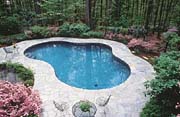
You have been a successful stone quarrier, fabricator, installer or supplier, with a solid sales strategy. Or so you think. What you may not realize is that you could be missing an important opportunity to promote your products. How? Through architects. We are not talking about "selling" to architects who, unlike the project's owners, contractors or installers, are not the ones purchasing products directly from you. Rather, we are talking about the opportunity to develop a sales strategy that "influences" the architects.
So, why try to influence them? Why devote a significant amount of your time, money and resources promoting your wares to a group of people who will not spend a nickel on them? Because if you are not getting in front of this very influential group, you may be missing a significant opportunity to sell your stone products. Architects, as we all know, create unique structures and suitable environments for their clients, and have a tremendous amount of control and impact on what products are used to construct their designs. Historically speaking, architects are responsible for selecting 95% of the products installed on an average-size project.
A recent study designed to uncover how architects make product decisions yielded a particularly interesting fact: architects, on average, must select 1,500 products and make over 17,000 decisions on what is best for the project and the owner. That's 17,000 answers to 17,000 very important questions. How big? How high? What color? What shape? What style? Moreover, what products will give the owner exactly what they have paid the architect to design? The list of questions about what products to incorporate in a project can be overwhelming for architects and their clients.
It is impossible for an architect to know every detail on all these products. By nature, they are generalists, but they carry a complexity of responsibilities. Architects are the design creators who desperately need trusted product information providers, someone they can rely on to provide objective answers and help them determine the right product for their project. An effective stone strategy, therefore, should not center on selling to architects. Instead, focus on influencing architects to incorporate stone products using the three E's: Education, Ease and Execution.

Education
If you want architects to use your stone products, do not simply peddle them. Instead, teach them about your products. There is a difference. They want to know what your product will do, how it will perform and what its capabilities, applications and limitations are. Most salespeople are used to selling customers on their product knowledge, the features and benefits of their stone products and how consumer-friendly their company is. Marketing to architects goes beyond casual references to the basic features and benefits of the products. The architect, who carries the liability for any construction project, must know everything there is to know about the product. Promoters of stone products have numerous tools for educating architects. For example:
- General product guide: A brochure or pamphlet highlighting basic use and application of your products. You want to objectively educate, so limit this guide to the features and benefits of the products and company history.
- Photographs: Show the architect some finished projects using your stone. Tell them about the project, who was involved, what the application was, and if there were any problems.
- Guide specifications: A clear, concise and accurate document describing and defining the characteristics of your product. If relevant, it could also include proper installation techniques and quality control.
- Samples: Provide accurate examples of what the finished product will look like.
- Continuing Education: Develop a non-biased educational program that demonstrates your product and industry knowledge. By establishing yourself as an authority (you don't have to be an expert), you say a lot about your products, your company and your commitment to the architectural community.
- Trade shows: And, not just the stone industry shows. Participation in local, regional, and/or national design professional organizations, like AIA, ASLA and CSI, helps promote your commitment to their profession and helps establish your product brand.
Ease
People outside the stone industry may find our products confusing. Architects, in particular, may find it challenging to specify and incorporate stone into their design. We have all heard or seen architect project specifications like: "the stone shall be a quarried fieldstone" or "the stone shall be of the highest quality bluestone slate." With so many stone colors, shapes, sizes and textures coming from many different stone companies, it's no wonder architects can get confused. However, in that confusion, there is opportunity. For the person or company that makes it easy for the architect to understand, easy to select and easy to specify, the reward can be a mutually beneficial relationship between stone provider and architect. Making the job easier for architects can result in architects making it easier for you to sell your product. For example, stone installers may call out of the blue for a quote on a project where your stone has been listed as the approved material. New business like this is the direct result of a good strategy influencing the architect.Execution
No, this does not refer to corporal punishment of an architect. Here, execution simply means: do what you say you will do. We all know the merits of the adage "under promise and over deliver." Regardless of what business or industry you are in, if you cannot deliver what you promise, it is only a matter of time until sales come to a screeching halt. The same principle applies to doing business with architects. If you offer to ship stone samples, write a product description or review the architect's specification for accuracy, then deliver what you promised. Your goal when influencing architects is to gain credibility so that when the architect is designing a project with stone, your company is the first one he calls. Failure to execute on what you offer is the fastest way to taint your reputation and limit your opportunities.In closing, the decision to develop a sales strategy to influence architects can be a difficult one. The structures and landscapes they design can take months, even years, to progress to the construction phase and the return on your investment may not be immediate. Nevertheless, whether or not you decide to incorporate this strategy, one thing is not debatable -- architects love stone. They truly love it. Longevity, versatility and perceived value of stone are all key elements that make it a favorite product among the design community. Architects want to know more about it. But, they do not want to be "sold" on it. If you have the time and resources to invest in influencing architects, remembering the three E's will help you improve your chances of selling your stone and improving your company's bottom line.


